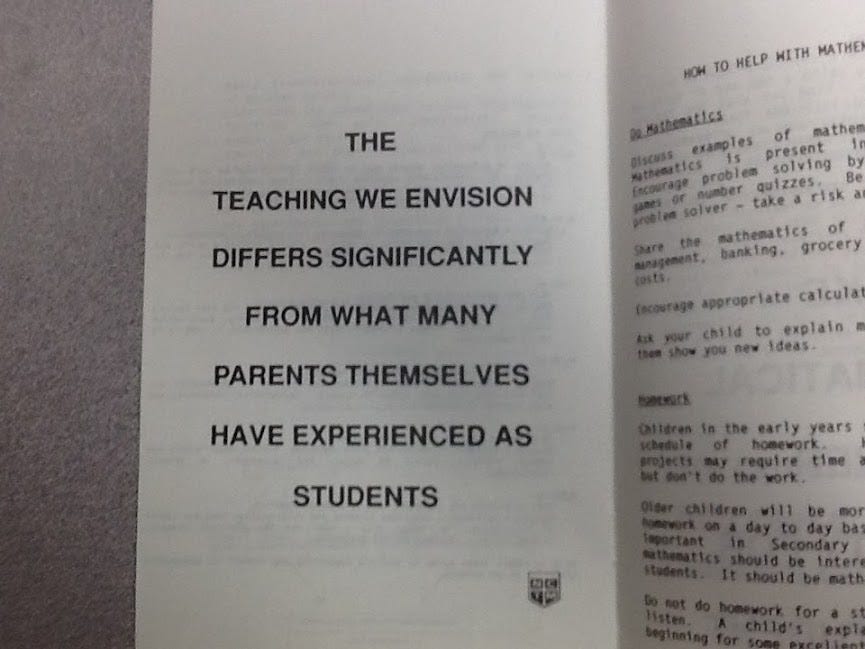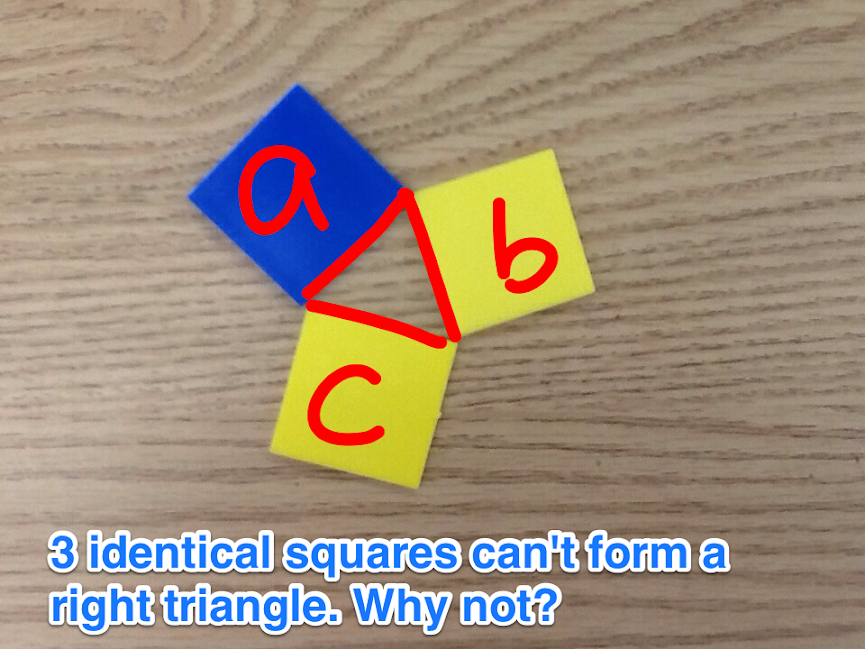A Modest Research Proposal for Math Ed
A Modest Research Proposal for Mathematics Education
Many thousands, or perhaps millions, of words have been written, in favour of either a “back to basics” approach to mathematics education, or in favour of more “constructivist” approaches. This debate is polarized, political, and at times vicious, but it is a necessary one. This debate plays out in the constant push and pull between past curricular approaches (what worked? what didn’t work?), and the need to keep refreshing them, as we move into the future.
For mathematics educators, this debate never ends. At its most reductive, we have the constant media cycle which reduces mathematics teaching and learning to test scores, and often a yearning for a past in which students were more proficient with times tables and number facts. The reductive argumentative move the “other side” takes is to deride past mathematics instruction as producing “zombie” learners who are capable of little more than spitting back formulas and algorithms on tests.
One the one hand, we have a real or perceived loss of “basic skills”, usually signified in the debate through times instant recall, and on the other hand, we have the idea that our students are not good enough at problem-solving for the “modern world”, or for “the future”.
It is very worth noting that this debate is several generations old.


that the sentiment depicted in the picture below was published in 1991. A generation later, and we are seemingly still stuck, wheels in the mud of the same debate.
Mathematics teaching and learning has progressed in many ways since 1989, when NCTM reform began. It has also progressed in many ways since the 1960s, when the first “New Math” curricula were tried (and eventually abandoned). What seems like a consistent path of tinkering, or even failed reform, is actually a continual refinement of teaching practice. That is to say, improvement in curriculum and practice is subtle, but constant. Teaching itself is an iterative art. Polarizing dichotomies are for politicians, not for teachers.
Teachers are best at teaching. It is their art and craft. Simply put: the embodied knowledge of mathematics and how to teach it is constantly evolving and updating, as new teachers enter the profession, and older ones leave it. There is a constant and steady rate of change, however slow. Time moves forward, and so do we.
But research can inform teaching. This article is an attempt to point the way forward to future types of research that can inform teacher practice in mathematics education.
A False Dichotomy?
An interesting article by H. Wu (1999) characterizes the basic skills vs. conceptual understanding debate as a “false dichotomy.”
A lengthy quotation will help make this point:
In mathematics education, this debate takes the form of “basic skills or conceptual understanding.” This bogus dichotomy would seem to arise from a common misconception of mathematics held by a segment of the public and the education community: that the demand for precision and fluency in the execution of basic skills in school mathematics runs counter to the acquisition of conceptual understanding. The truth is that in mathematics, skills and understanding are completely intertwined. In most cases, the precision and fluency in the execution of the skills are the requisite vehicles to convey the conceptual understanding. There is not “conceptual understanding” and “problem-solving skill” on the one hand and “basic skills” on the other.
The author clearly is questioning the myth, a pervasive one, that conceptual understanding *must* come first. Consider that both procedural understanding (what we could broadly call “basic” skills) and conceptual understanding are interwined, or interwoven-as in a thick braid of rope, where both strands are seamlessly woven together.
It is my belief that educators, researchers, and those who write articles for newspapers need to drop the belief that one must precede the other. Future research studies could test the acquisition of what we could broadly call the “procedural condition”, and the “conceptual condition”.
Let’s give the seemingly simple example of teaching the Pythagorean relationship.
Consider two groups of students, going down the following two instructional paths.
Instructional Path One
- Write down the formula on the board. Explain how this formula works.
- Give a set of questions for students to work. Show them how to work through to solving for the hypotenuse.
- Vary the questions by having students solve for either leg.
- Address misconceptions and problems.
- Give students more complicated problems, and assess them on their understanding.
Instructional Path Two
- Show students a geometric proof of the theorem. Have them attach squares to the sides of right-angled triangles. Examine the relationship you find.
- Translate your findings into algebra. The “picture” created by the geometric representation is translated into algebraic form.
- Show students how to work the formula. Give them questions to practice.
4. Give students more complicated problems, and assess them on their understanding.
The substantial difference here is the geometric element in the second path. But this element could be worked into the first instructional path, perhaps later on.
You can decide for yourself where the following prompt belongs in the instructional path. Toward the beginning? When exploring the theorem? Or at the end, as a way to push students’ thinking, after they have mastered the algebra?


Our research question could be: will these two groups of students both understand the Pythagorean relationship in the same way and to the same depth? If we can draw a firm conclusion from our research study, then we might come down on the procedural or conceptual side, and if not, then we might conclude that the endpoint of both groups is roughly equal. Worth noting here: both paths have what would be called procedural and conceptual elements. There is a real back and forth between them.
A Back-and-Forth, or Iteration Between Procedural and Conceptual Understanding
If we are going back-and-forth, and forth-and-back between procedural and conceptual understanding, over a certain period of instructional time, then there are no hard and fast barriers between these two categories.
A paper by Rittle-Johnson, Siegler, and Alibali (2001) helpfully makes this point, and possibly points the way forward for future research. They note that typically we see one “type” of knowledge as precedent to the other. The authors believe it need not be so, and that it is fruitless to do so:
In contrast to this past research and theory, we propose that throughout development, conceptual and procedural knowledge influence one another. Specifically, we propose that conceptual and procedural knowledge develop iteratively, with increases in one type of knowledge leading to increases in the other type of knowledge, which trigger new increases in the first.
The design of the study (in two parts, n=74, and n=59)was to have students placing decimal fractions (decimals under 1) on a number line. They characterized this task as procedural. Their conclusions were that procedural knowledge informed conceptual knowledge, and vice versa. Most excitingly, both seemed to support better problem representation.
Representation is an enactment of thinking; students must have ways to think about mathematical concepts. Our goal is more than being able to just carry out a procedure, or just to think in general ways about math concepts. We need to bring the concepts into being in the world. As the authors note, domain knowledge contains both skills and concepts.
The study points to the idea that representation is complex. A procedure, for example, can be thought about, and it can, and should be, explained and represented. Treating a procedure as completely a separate “thing” from a concept, for example, is probably a bad thing. The standard algorithm for multiplication is bound up in notions of place value, and the taking of partial products, which are then totalled. There is no reason that teaching this procedure can’t be an iterative process-concept and skill tied into what we call “learning the algorithm.”
Future studies of this kind could seek to further explore how this iteration happens. How do procedures and concepts work together, not against each other? Accepting that they do not have to work against each other, and indeed, that they can and must work together, would be a start.
How do procedures and concepts work together to create mathematical understanding?
Only the most hardcore dichotomist would refuse to accept, at this point, that there is common ground to be found. It is on this common ground that, one day, the armistice of the “Math Wars” will be signed. Or, at least, we will have better and more research that shows that it is even possible to meet on common ground.
References:
Rittle-Johnson, B., Siegler, R. S., & Alibali, M. W. (2001). Developing conceptual understanding and procedural skill in mathematics: An iterative process. Journal of Educational Psychology, 93(2), 346–362.
Wu, H. Basic Skills versus Conceptual Understanding. A Bogus Dichotomy in Mathematics Education. American Educator, v23 n3 p14–19,50–52 Fall 1999
